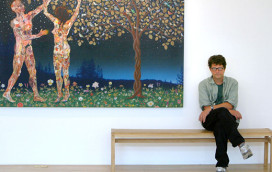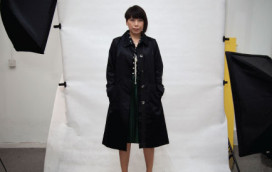“I started with watches. Then it was cars. Now it’s art,” says Nirav Modi. He’s describing his progression as a collector, which has resulted in the superb array of artworks that adorn the Mumbai headquarters of his eponymous jewelry brand. Having recently opened stores in London and Manhattan, Modi has turned the jewelry house he launched in 2010 into a globally recognized contemporary Indian luxury brand. Like his jewelry, which is produced entirely in Mumbai, his art was created almost entirely in India, spanning the century between India’s struggle for independence and its current status as an economic powerhouse.
Today, the jeweler owns about 500 pieces of art – some of which are hung in the oceanfront duplex he shares with his wife and three children, and others at their beach house in Alibag, where fashionable Bombayites head for the weekend. Most of the collection, though, is kept at the company’s offices (designed by his mother, an interior designer) and displayed in rotation. Apart, that is, from a few works that never leave his own office: a sculpture of brass cowpats by the contemporary artist Subodh Gupta; Boy With Lemons, a painting by Amrita Sher-Gil, the bold female artist of the Twenties and Thirties sometimes described as India’s Frida Kahlo; and a haunting photographic portrait of Sher-Gil taken by her nephew, Vivan Sundaram.
Having grown up in Antwerp, where his family were diamond dealers, and visited the museums of Rome, Paris and Brussels with his mother, Modi says he was attracted to art from a young age. Although at home, “dinner table conversation was all about diamonds: diamonds bought, diamonds sold, diamonds cut”, as a young man he became obsessed with other objects of beauty. His first passion was watches – beginning with one he just had to have. “I spent my first six months’ wages on an IWC perpetual calendar watch,” he recalls, followed by a series of extraordinarily complicated models, from fine watchmakers such as Philippe Dufour. After that, he discovered cars – “mostly British” – although living in Mumbai, he points out with a wry smile, you don’t really get the chance to make the most of a high-performance automobile.
It was only in the Nineties that he started to collect art. “As I was living in India,” he says, “I was most influenced by the Indian modern art I was seeing around me.” Today, Indian art from 1850 until 1970 makes up the core of his collection, which now encompasses something close to a complete canon of artists of that period, and some of its greatest masters. Like most serious collectors, though, for Modi there’s always something missing, something more to add – including, he says, “a masterpiece by Tyeb Mehta” (one of the Bombay Progressive Artists’ Group who gained international recognition in the Sixties and Seventies).
According to Mallika Advani, the former head of Christie’s in India who has been Modi’s art adviser for many years, the jeweler is “the dream collector. He knows what he wants and how to work the primary market, but he’s also very good at auction.” He also has, she explains, a passionate desire to acquire key pieces that he believes will enhance his collection, enough knowledge to know when to buy a piece and when to wait, and what he’s missed out on, so he can try and buy it later.
The choice to display the collection – and rotate the display – at the semi-public space of his offices rather than at home is a deliberate one, Modi explains. “Art inspires me. There are pieces I’ve had on walls for years and suddenly I notice a nuance, despite having seen the works day in, day out. This quality of art is fascinating. I wanted to create an environment where more people would have the opportunity to be immersed in it.”
niravmodi.com
Your address: The St. Regis Mumbai



